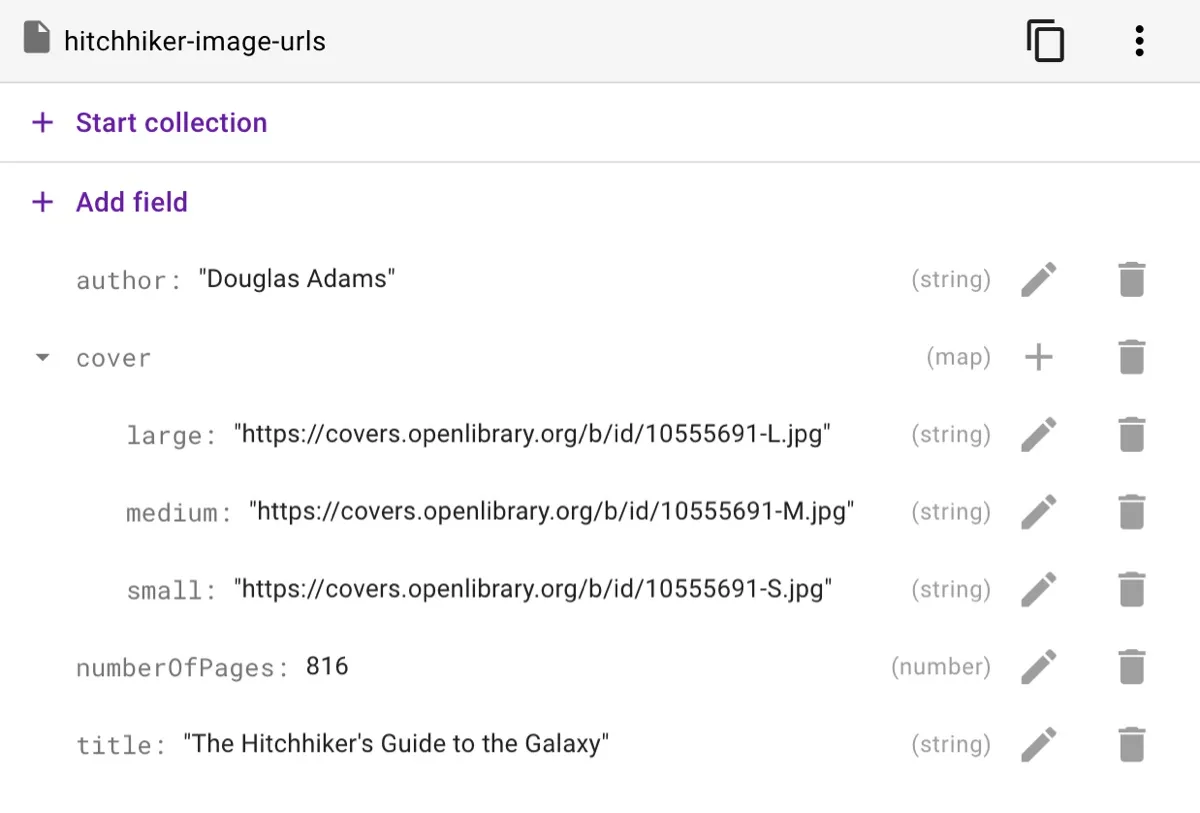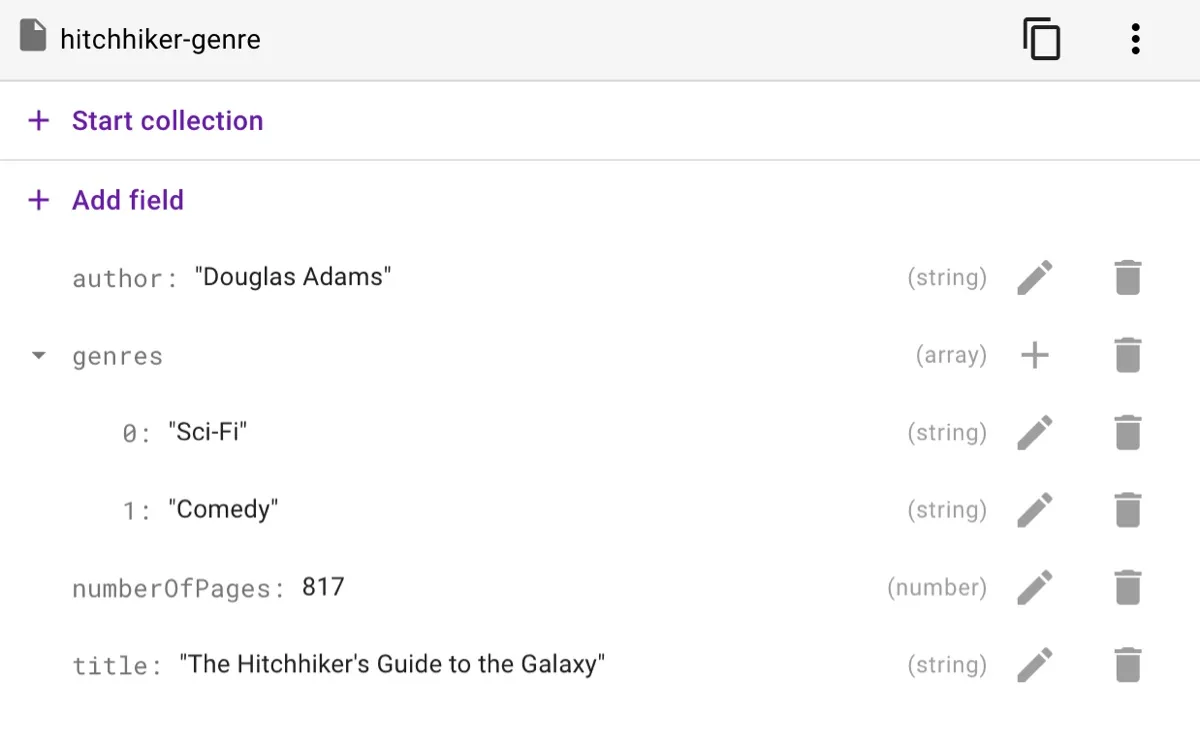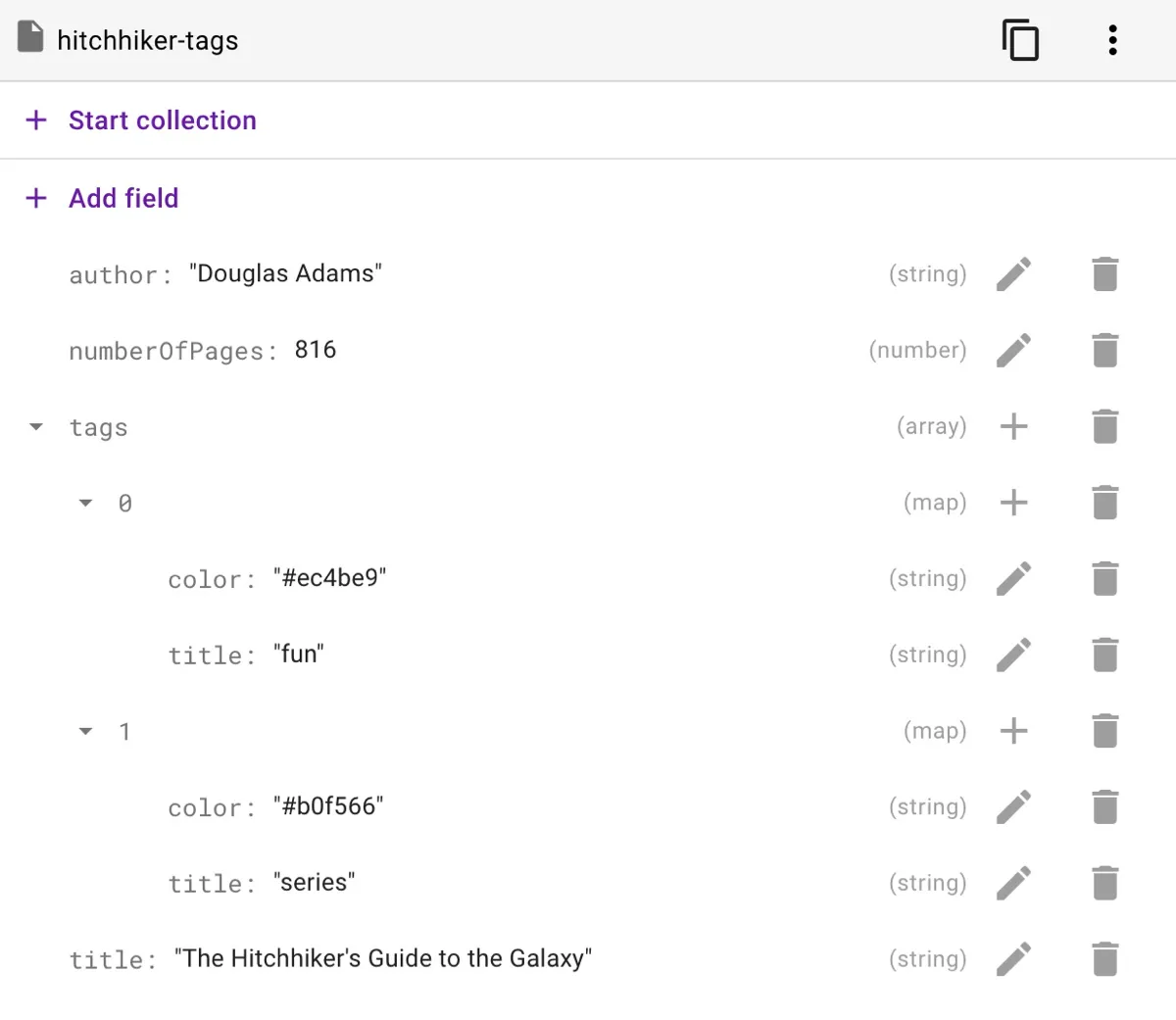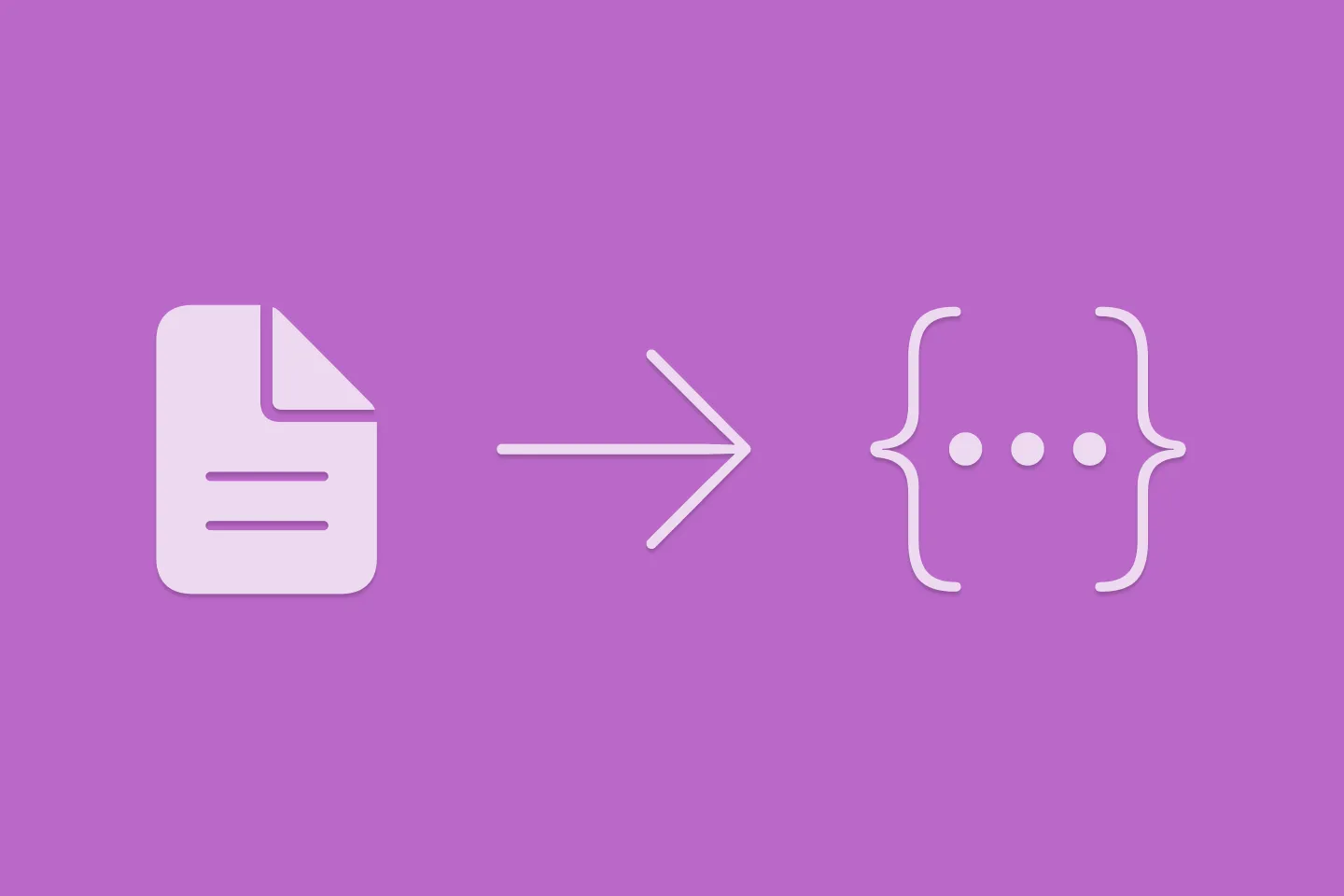Mapping Firestore Data in Swift
The Comprehensive Guide
Swift’s Codable API, introduced in Swift 4, enables us to leverage the power of the compiler to make it easier to map data from serialised formats to Swift types.
You might have been using Codable to map data from a web API to your app’s data model (and vice versa), but it is much more flexible than that.
In this article, we’re going to look at how Codable can be used to map data from Firestore to Swift types and vice versa.
If you’re new to Cloud Firestore - it is a horizontally scaling NoSQL document database in the cloud, part of Firebase’s Backend-as-a-Service products. Data is stored in documents that contain fields mapping to values. Documents are stored in collections, which you can think of as containers that you can use to organise your data. Documents support many data types such as strings and numbers, but also complex, nested objects. You can even create subcollections within documents, and build hierarchical data structures.
When fetching a document from Firestore, your app will receive a dictionary of key/value pairs (or an array of dictionaries, if you use one of the operations returning multiple documents).
Now, you can certainly use dictionaries in Swift, and they offer some great flexibility that might be exactly what your use case calls for. However, this approach isn’t type-safe and it’s easy to introduce hard-to-track-down bugs by misspelling attribute names, or forgetting to map that new attribute your team added when they shipped that exciting new feature last week.
In the past, many developers have worked around these shortcomings by implementing a simple mapping layer that allowed them to map dictionaries to Swift types. But again, most of these implementations are based on manually specifying the mapping between Firestore documents and the corresponding types of your app’s data model.
With Firestore’s support for Swift’s Codable API, this becomes a lot easier:
- You will no longer have to manually implement any mapping code
- It’s easy to define how to map attributes with different names
- It has built-in support for many of Swift’s types
- And it’s easy to add support for mapping custom types
And - best of all: for simple data models, you won’t have to write any mapping code at all.
Mapping Data
Cloud Firestore stores data in documents which map keys to values. To fetch data from an individual document, we can call DocumentSnapshot.data(), which returns a dictionary mapping the field names to an Any: func data() -> [String : Any]?.
This means we can use Swift’s subscript syntax to access each individual field, like this:
#warning("DO NOT MAP YOUR DOCUMENTS MANUALLY. USE CODABLE INSTEAD.")
func fetchBook(documentId: String) {
let docRef = db.collection("books").document(documentId)
docRef.getDocument { document, error in
if let error = error as NSError? {
self.errorMessage = "Error getting document: \(error.localizedDescription)"
}
else {
if let document = document {
let id = document.documentID
let data = document.data()
let title = data?["title"] as? String ?? ""
let numberOfPages = data?["numberOfPages"] as? Int ?? 0
let author = data?["author"] as? String ?? ""
self.book = Book(id:id, title: title, numberOfPages: numberOfPages, author: author)
}
}
}
}While it might seem straightforward and easy to implement, this code is fragile, hard to maintain, and error-prone. As you can see, we’re making assumptions about the data types of the document fields . These might or might not be correct (remember, as there is no schema, you can easily add a new document to the collection and choose a different type for a field - you might accidentally choose string for the numberOfPages field, which would result in a difficult-to-find mapping issue). Also, you’ll have to update your mapping code whenever a new field is added, which is rather cumbersome. And let’s not forget that we’re not taking advantage of Swift’s strong type system, which knows exactly what’s the correct type for each of the properties of Book .
So, please don’t map your documents manually - use Codable instead!
What is Codable, anyway?
According to Apple’s documentation, Codable is “a type that can convert itself into and out of an external representation.” In fact, Codable is a type alias for the Encodable and Decodable protocols. By conforming a Swift type to this protocol, the compiler will synthesise the code needed to encode/decode an instance of this type from a serialised format, such as JSON.
A simple type for storing data about a book might look like this:
struct Book: Codable {
var title: String
var numberOfPages: Int
var author: String
}As you can see, conforming the type to Codable is minimally invasive - we only had to add the conformance to the protocol, no other changes are required.
With this in place, we can now easily encode a book to a JSON object:
do {
let book = Book(title: "The Hitchhiker's Guide to the Galaxy",
numberOfPages: 816,
author: "Douglas Adams")
let encoder = JSONEncoder()
let data = try encoder.encode(user)
}
catch {
print("Error when trying to encode book: \(error)")
}Decoding a JSON object to a Book instance works as follows:
let decoder = JSONDecoder()
let decodedBook = try decoder.decode(Book.self, from: data)For more details about Codable, I recommend the following resources:
- John Sundell has a nice article about the Basics of Codable
- If books are more your thing, check out Mattt’s Flight School Guide to Swift Codable
- And finally, Donny Wals has an entire series about Codable.
Mapping simple types using Codable
Firestore supports a broad set of data types, ranging from simple strings to nested maps. Most of these correspond directly to Swift’s built-in types. Let’s take a look at mapping some simple data types first before we dive into the more complex ones.
To map Firestore documents to Swift types, follow these steps:
- Add
FirebaseFirestoreSwiftto your project. You can use either CocoaPods or the Swift Package Manager to do so. - Import
FirebaseFirestoreSwift - Conform your type to
Codable - Add an
idproperty to your type, and use@DocumentIDto tell Firestore to map this to the document ID - Use
documentReference.data(as: )to map a document reference to a Swift type - Use
documentReference.setData(from: )to map data from Swift types to a Firestore document - (optional, but highly recommended) Implement proper error handling
Let’s update our Book type accordingly:
struct Book: Codable {
@DocumentID var id: String?
var title: String
var numberOfPages: Int
var author: String
}Since this type was already codable, we only had to add the id property and annotate it with the @DocumentID property wrapper.
Taking the previous code snippet for fetching and mapping a document, we can replace all the manual mapping code with a single line:
func fetchBook(documentId: String) {
let docRef = db.collection("books").document(documentId)
docRef.getDocument { document, error in
if let error = error as NSError? {
self.errorMessage = "Error getting document: \(error.localizedDescription)"
}
else {
if let document = document {
do {
self.book = try document.data(as: Book.self)
}
catch {
print(error)
}
}
}
}
}You can even write this more concisely by specifying the type of the document when calling getDocument(as:). This will perform the mapping for you, and return a Result type containing the mapped document or an error in case decoding failed:
private func fetchBook(documentId: String) {
let docRef = db.collection("books").document(documentId)
||> docRef.getDocument(as: Book.self) { result in<||
switch result {
case .success(let book):
// A Book value was successfully initialized from the DocumentSnapshot.
self.book = book
self.errorMessage = nil
case .failure(let error):
// A Book value could not be initialized from the DocumentSnapshot.
self.errorMessage = "Error decoding document: \(error.localizedDescription)"
}
}
}Updating an existing document is as simple as calling documentReference.setData(from: ). Including some basic error handling, here is the code to save a Book instance:
func updateBook(book: Book) {
if let id = book.id {
let docRef = db.collection("books").document(id)
do {
||> try docRef.setData(from: book)<||
}
catch {
print(error)
}
}
}When adding a new document, Firestore will automatically take care of assigning a new document ID to the document. This also works when the app is currently offline.
func addBook(book: Book) {
let collectionRef = db.collection("books")
do {
||> let newDocReference = try collectionRef.addDocument(from: self.book)<||
print("Book stored with new document reference: \(newDocReference)")
}
catch {
print(error)
}
}In addition to mapping simple data types, Firestore supports a number of other datatypes, some of which are structured types that you can use to create compound types inside a document.
Mapping nested custom types
Most attributes we want to map in our documents are simple values, such as the book’s title or the author’s name. But what about those cases when we need to store a more complex object? For example, we might want to store the URLs to the book’s cover in different resolutions.
The easiest way to do this in Firestore is to use a map:
 When writing the corresponding Swift
When writing the corresponding Swift struct, we can make use of the fact that Firestore supports URLs - when storing a field that contains a URL, it will be converted to a string and vice versa (see FirestoreEncoder.swift):
struct CoverImages: Codable {
var small: URL
var medium: URL
var large: URL
}
struct BookWithCoverImages: Codable {
@DocumentID var id: String?
var title: String
var numberOfPages: Int
var author: String
var cover: CoverImages?
}Notice how we defined a struct, CoverImages , for the cover map in the Firestore document. By marking the cover property on BookWithCoverImages as optional, we’re able to handle the fact that some documents might not contain a cover attribute.
If you’re curious why there is no code snippet for fetching or updating data, you will be pleased to hear that there is no need to adjust the code for reading or writing from/to Firestore: all of this works with the code we’ve written in the initial section.
Mapping arrays
Sometimes, we want to store a collection of values in a document. The genres of a book are a good example: a book like The Hitchhiker’s Guide to the Galaxy might fall into several categories - in this case Sci-Fi and Comedy:

In Firestore, we can model this using an array of values. This is supported for any codable types (such as String, Int, etc.). The following shows how to add an array of genres to our Book model:
public struct BookWithGenre: Codable {
@DocumentID var id: String?
var title: String
var numberOfPages: Int
var author: String
||> var genres: [String]<||
}Since this works for any codable type, we can use custom types as well. Imagine we’d want to store a list of tags for each book. Along with the name of the tag, we’d like to store the color of the tag as well, like this:

To store tags in this way, all we need to do is implement a Tag struct to represent a tag and make it codable:
struct Tag: Codable, Hashable {
var title: String
var color: String
}And just like that, we can store an array of Tags in our Book documents!
struct BookWithTags: Codable {
@DocumentID var id: String?
var title: String
var numberOfPages: Int
var author: String
||> var tags: [Tag]<||
}A quick word about mapping document IDs
Before we move on to more mapping more types, let’s talk about mapping document IDs for a moment.
We’ve used the @DocumentID property wrapper in some of the previous examples to map the document ID of our Firestore documents to the id property of our Swift types. This is important for a number of reasons: one, it helps us to know which document to update in case the user makes local changes. And two, SwiftUI’s List requires its elements to be Identifiable in order to prevent elements from jumping around when they get inserted.
It’s worth pointing out that an attribute marked as @DocumentID will not be encoded by Firestore’s encoder when writing the document back. This is because the document ID is not an attribute of the document itself - so writing it to the document would be a mistake.
When working with nested types (such as the array of tags on the Book in an earlier example in this article), it is not required to add an @DocumentID property: nested properties are a part of the Firestore document, and do not constitute a separate document. Hence, they do not need a document ID.
Mapping dates and times
Firestore has a built-in data type for handling dates and times, and - thanks to Firestore’s support for Codable, it’s straightforward to use them.
Let’s take a look at this document which represents the mother of all programming languages, Ada - invented in 1843:

A Swift type for mapping this document might look like this:
struct ProgrammingLanguage: Codable {
@DocumentID var id: String?
var name: String
var year: Date
}We cannot leave this section about dates and times without having a conversation about @ServerTimestamp. This property wrapper is a powerhouse when it comes to dealing with timestamps in your app.
In any distributed system, chances are that the clocks on the individual systems are not completely in sync all of the time. You might think this is not a big deal, but imagine the implications of a clock running slightly out of sync for a stock trade system: even a millisecond deviation might result in a difference of millions of dollars when executing a trade.
Firestore handles attributes marked with @ServerTimestamp as follows: if the attribute is nil when you store it (using addDocument, for example), Firestore will populate the field with the current server timestamp at the time of writing it into the database. If the field is not nil when you call addDocument() or updateData(), Firestore will leave the attribute value untouched. This way, it is easy to implement fields like createdAt and lastUpdatedAt.
Mapping GeoPoints
One of the most magical experiences when I got my first smartphone was to be able to pinpoint my exact location on a map and find the nearest café. Many exciting features become possible by storing geolocations. For example, it might be useful to store a location for a task so your app can remind you about a task when you reach a destination.
Firestore has a built-in data type GeoPoint that can store the longitude and latitude of any location. To map locations from / to a Firestore document, we can use the GeoPoint type:
struct Office: Codable {
@DocumentID var id: String?
var name: String
var location: GeoPoint
}Converting a GeoPoint to a CLLocationCoordinate2D is a straight-forward operation:
CLLocationCoordinate2D(latitude: office.location.latitude,
longitude: office.location.longitude)To learn more about querying documents by physical location, check out this solution guide.
Mapping Colors
“How can I map colors” is one of the most frequently asked questions, not only for Firestore, but for mapping between Swift and JSON as well. There are plenty of solutions out there, but most of them focus on JSON, and almost all of them map colors as a nested dictionary composed of its RGB components.
I’ve been mildly dissatisfied with all of these solutions and always felt there should be a better, simpler solution. Why don’t we use web colors (or, to be more specific, CSS hex color notation) - they’re easy to use (essentially just a string), and they even support transparency!
To be able to map a Swift Color to its hex value, we need to create a Swift extension that adds Codable to Color.
extension Color: Codable {
init(hex: String) {
let rgba = hex.toRGBA()
self.init(.sRGB,
red: Double(rgba.r),
green: Double(rgba.g),
blue: Double(rgba.b),
opacity: Double(rgba.alpha))
}
public init(from decoder: Decoder) throws {
let container = try decoder.singleValueContainer()
let hex = try container.decode(String.self)
self.init(hex: hex)
}
public func encode(to encoder: Encoder) throws {
var container = encoder.singleValueContainer()
try container.encode(toHex)
}
//... (code for translating between hex and RGBA ommitted for brevity)
}By using decoder.singleValueContainer(), we can decode a String to its Color equivalent, without having to nest the RGBA components. Plus, you can use these values in the web UI of your app, without having to convert them first!
With this, we can update code for mapping tags, making it easier to handle the tag colors directly instead of having to map them manually in our app’s UI code:
struct Tag: Codable, Hashable {
var title: String
var color: Color
}
struct BookWithTags: Codable {
@DocumentID var id: String?
var title: String
var numberOfPages: Int
var author: String
var tags: [Tag]
}Mapping Enums
Enums are probably one of the most underrated language features in Swift - there’s much more to them than meets the eye. A common use case for enums is to model the discrete states of something. For example, we might be writing an app for managing articles. To track the status of an article, we might want to use an enum Status:
enum Status: String, Codable {
case draft
case inReview
case approved
case published
}Firestore doesn’t support enums natively (i.e. it cannot enforce the set of values), but we can still make use of the fact that enums can be typed, and choose a codable type. In this example, we’ve chosen String , which means all enum values will be mapped to/from string when stored in a Firestore document.
And, since Swift supports custom raw values, we can even customise which values refer to which enum case. So for example, if we decided to store the Status.inReview case as in review, we could just update the above enum as follows:
enum Status: String, Codable {
case draft
case inReview = "in review"
case approved
case published
}Customising the mapping
Sometimes, the attribute names of the Firestore documents we want to map don’t match up with the names of the properties of our data model in Swift. For example, one of our coworkers might be a Python developer, and decided to choose snake_case for all their attribute names 🐍.
Not to worry - Codable has us covered!
For cases like these, we can make use of CodingKeys . This is an enum we can add to a codable struct to specify how certain attributes will be mapped.
Consider this document:

To map this document to a struct that has a name property of type String, we need to add a CodingKeys enum to the ProgrammingLanguage struct, and specify the name of the attribute in the document:
struct ProgrammingLanguage: Codable {
@DocumentID var id: String?
var name: String
var year: Date
enum CodingKeys: String, CodingKey {
case id
case name = "language_name"
case year
}
}By default, the Codable API will use the property names of our Swift types to determine the attribute names on the Firestore documents we’re trying to map. So as long as the attribute names match, there is no need to add CodingKeys to our codable types. However, once we use CodingKeys for a specific type, we need to add all property names we want to map. Any property that is not listed as a case on the respective CodingKeys enum will be ignore during the mapping process.
This can actually be convenient if we specifically want to exclude some of the properties from being mapped.
So for example, if we want to exclude the reasonWhyILoveThis property from being mapped, all we need to do is to remove it from the CodingKeys enum:
struct ProgrammingLanguage: Identifiable, Codable {
@DocumentID var id: String?
var name: String
var year: Date
var reasonWhyILoveThis: String = ""
enum CodingKeys: String, CodingKey {
case id
case name = "language_name"
case year
}
}Occasionally we might want to write an empty attribute back into the Firestore document. Swift has the notion of optionals to denote the absence of a value, and Firestore supports null values as well. However, the default behaviour for encoding optionals that have a nil value is to just omit them. @ExplicitNull gives us some control over how Swift optionals are handled when encoding them: by flagging an optional property as @ExplicitNull, we can tell Firestore to write this property to the document with a null value if it contains a value of nil.
Error Handling
In the above code snippets I intentionally kept error handling at a minimum, but in any production app, you’ll want to make sure to gracefully handle any errors.
Here is a code snippet that show how to use handle any error situations you might run into:
class MappingSimpleTypesViewModel: ObservableObject {
@Published var book: Book = .empty
@Published var errorMessage: String?
private var db = Firestore.firestore()
func fetchAndMap() {
fetchBook(documentId: "hitchhiker")
}
func fetchAndMapNonExisting() {
fetchBook(documentId: "does-not-exist")
}
func fetchAndTryMappingInvalidData() {
fetchBook(documentId: "invalid-data")
}
private func fetchBook(documentId: String) {
let docRef = db.collection("books").document(documentId)
docRef.getDocument(as: Book.self) { result in
switch result {
case .success(let book):
// A Book value was successfully initialized from the DocumentSnapshot.
self.book = book
self.errorMessage = nil
case .failure(let error):
// A Book value could not be initialized from the DocumentSnapshot.
switch error {
case DecodingError.typeMismatch(_, let context):
self.errorMessage = "\(error.localizedDescription): \(context.debugDescription)"
case DecodingError.valueNotFound(_, let context):
self.errorMessage = "\(error.localizedDescription): \(context.debugDescription)"
case DecodingError.keyNotFound(_, let context):
self.errorMessage = "\(error.localizedDescription): \(context.debugDescription)"
case DecodingError.dataCorrupted(let key):
self.errorMessage = "\(error.localizedDescription): \(key)"
default:
self.errorMessage = "Error decoding document: \(error.localizedDescription)"
}
}
}
}
}The previous code snippet demonstrates how to handle errors when fetching a single document. In addition to fetching data once, Firestore also supports delivering updates to your app as they happen, using so-called snapshot listeners: we can register a snapshot listener on a collection (or query), and Firestore will call our listener whenever there is an update.
Here is a code snippet that show how to register a snapshot listener, map data using Codable, and handle any errors that might occur. It also shows how to add a new document to the collection. As you will see, there is no need to update the local array holding the mapped documents ourselves, as this is taken care of by the code in the snapshot listener.
class MappingColorsViewModel: ObservableObject {
@Published var colorEntries = [ColorEntry]()
@Published var newColor = ColorEntry.empty
@Published var errorMessage: String?
private var db = Firestore.firestore()
private var listenerRegistration: ListenerRegistration?
public func unsubscribe() {
if listenerRegistration != nil {
listenerRegistration?.remove()
listenerRegistration = nil
}
}
func subscribe() {
if listenerRegistration == nil {
listenerRegistration = db.collection("colors")
.addSnapshotListener { [weak self] (querySnapshot, error) in
guard let documents = querySnapshot?.documents else {
self?.errorMessage = "No documents in 'colors' collection"
return
}
self?.colorEntries = documents.compactMap { queryDocumentSnapshot in
let result = Result { try queryDocumentSnapshot.data(as: ColorEntry.self) }
switch result {
case .success(let colorEntry):
if let colorEntry = colorEntry {
// A ColorEntry value was successfully initialized from the DocumentSnapshot.
self?.errorMessage = nil
return colorEntry
}
else {
// A nil value was successfully initialized from the DocumentSnapshot,
// or the DocumentSnapshot was nil.
self?.errorMessage = "Document doesn't exist."
return nil
}
case .failure(let error):
// A Book value could not be initialized from the DocumentSnapshot.
switch error {
case DecodingError.typeMismatch(_, let context):
self?.errorMessage = "\(error.localizedDescription): \(context.debugDescription)"
case DecodingError.valueNotFound(_, let context):
self?.errorMessage = "\(error.localizedDescription): \(context.debugDescription)"
case DecodingError.keyNotFound(_, let context):
self?.errorMessage = "\(error.localizedDescription): \(context.debugDescription)"
case DecodingError.dataCorrupted(let key):
self?.errorMessage = "\(error.localizedDescription): \(key)"
default:
self?.errorMessage = "Error decoding document: \(error.localizedDescription)"
}
return nil
}
}
}
}
}
func addColorEntry() {
let collectionRef = db.collection("colors")
do {
let newDocReference = try collectionRef.addDocument(from: newColor)
print("ColorEntry stored with new document reference: \(newDocReference)")
}
catch {
print(error)
}
}
}All code snippets used in this post are part of a sample application that you can download from this GitHub repository.
Go forth and use Codable!
Swift’s Codable API provides a powerful and flexible way to map data from serialised formats to and from your applications data model. In this article, you saw how easy it is to use in apps that use Firestore as their data store.
Starting from a basic example with simple data types, we progressively increased the complexity of the data model, all the while being able to rely on Codable and Firebase’s implementation to perform the mapping for us.
There really is no reason for not using Firestore’s Codable support.
For additional information, follow me on Twitter and subscribe to my YouTube channel, where I regularly post content about Swift and Firebase.
Thanks for reading! 🔥

Turn Your Photos Into Miniature Magic with Nano Banana
Build stunning image generation apps in iOS with just a few lines of Swift

Reverse-Engineering Xcode's Coding Intelligence prompt
A look under the hood

Extracting structured data from PDFs using Gemini 2.0 and Genkit

Understanding SwiftUI Preferences
SwiftUI Parent / Child View Communication

